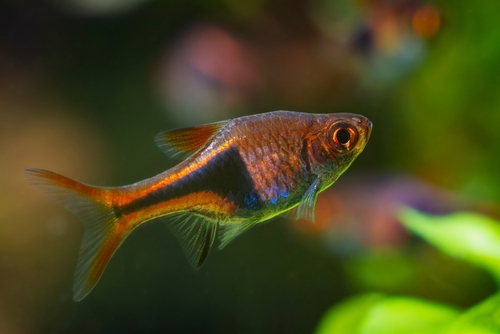Finding the best Harlequin Rasbora tank mates can be trickier than you might think. Although they are some of the most popular small fish for home aquariums, they are vulnerable due to their miniature size and peaceful nature. You need to be cautious if you want them to stay safe and unharmed in a healthy community.
In this article, we’re going to cover their top 13 tank mates and help you to find the perfect friends for your Harlequins so that all of your fish are as happy as possible.
Contents
Harlequin Rasbora Tank Mates – What You Need To Know
When you’re putting different species together, there are a lot of potential pitfalls that you want to avoid. You need to have a pretty solid understanding of your Harlequins to make sure they are not going to be bullied, harmed, or kept away from the space and food that they need.
When you’re choosing new tank mates, it’s important to consider:
Personality/Temperament
Harlequin Rasboras are some of the friendliest and most peaceful fish out there, so they need to be kept with like-minded species. More hostile or overly active tank mates can cause Harlequins to become stressed, even if they do not cause them direct harm.
The worst-case scenario is introducing a fish that is likely to view your Rasboras as food or a target. They are not able to defend themselves against other fish, so they can become hurt very easily.
Adult Size
Another factor that is always significant will be the comparative size between the species that are cohabiting. While some larger fish can get on with smaller fish, it is relatively rare, and Harlequin Rasboras will almost always be victimized by big tank mates.
The best option is to find a species that is similar in size, or at least relatively small and peaceful. Harlequins grow to around 1.5 – 2 inches, so anything less than 4 inches should be safe.
Resource Competition
One of the main things you are trying to avoid when you’re putting multiple fish species into a single environment is having any of them miss out on the vital resources that they need. Harlequin Rasboras are not forceful and they will often shy away from other fish, which means they can be kept away from vital nutrition and space.
Harlequins tend to spend most of their time in the top and middle parts of the tank, so you don’t want to overly fill their environment with other fish that live in this area.
This is not just an issue of choosing the right tank mates either, it’s also about organizing the tank itself. Harlequin Rasboras can live in a 10-gallon tank on their own but, depending on the size and number of additional fish you are hoping to add, you may need to consider a serious upgrade.
Tank Setup and Water Parameters
Of course, you can’t just put any fish into the same tank and hope they will survive. Each species has its own needs when it comes to the way the tank is set up and the type of water that it can live with, and getting this wrong can be a deadly mistake.
In terms of the parameters that Harlequin Rasboras need, you’ll want to look for tank mates that can be happy with:
- PH: 5 – 7
- Hardness: Soft to medium
- Temperature: 73 to 82 F (22 to 25 C)
15 Best Harlequin Rasbora Tank Mates
Now that we know more about what you’re looking for in a new friend for your Harlequins, we can talk about some of the best options out there. Fortunately, there are quite a few to choose from, since they are a relatively friendly and peaceful species and they don’t ask for too much.
You also shouldn’t miss these other popular posts:
1. Chili Rasbora
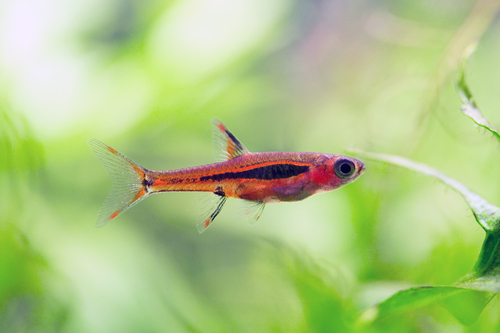
- Scientific Name: Boraras brigittae
- Adult Size: Around 0.7 inches
- Compatible with: Cory Catfish, Rosy Loaches, Ember Tetras
- Care Level: Moderate
- Origin: Indonesia
These tiny little cousins of the Harlequin Rasbora are a great option because they are so small that they pose no threat at all. In fact, they are among the smallest tropical fish that are housed in home aquariums. They are named for the bright red color that the males show when they are at their healthiest.
They are also incredibly active, which makes them a lot of fun to watch and enjoy throughout the day, but their miniature size means that they won’t disturb other fish when they’re out and about.
Pros:
- Very small and non-threatening to Harlequins
Cons:
- Need dense plant life to thrive
2. Cory Catfish
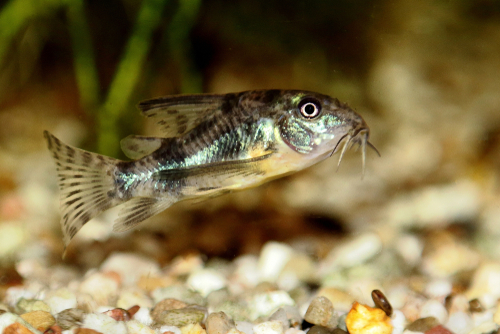
- Scientific Name: Corydoras paleatus
- Adult Size: 1 to 4 inches
- Compatible with: Tetras, Swordtails, Small Rasboras
- Care Level: Easy
- Origin: South America
You’ll see these fish mentioned often when it comes to community tanks, since they get on well with so many different species. Corydoras Catfish are just the right size to not intimidate Harlequins, and they are known to leave their tank mates to their own devices.
They also have a wonderfully unique appearance, with the characteristic whiskers that catfish are famous for but without the boisterous personalities that often come with them.
Pros:
- Very easy to care for and will leave Harlequins alone
Cons:
- Can become stressed if their tank is too full
3. Zebra Loach

- Scientific Name: Botia striata
- Adult Size: 3 to 4 inches
- Compatible with: Cherry Barbs, Celestial Pearl Danios, Neon Tetras
- Care Level: Easy
- Origin: India
These colorful and attractively-patterned fish are both hardy and relaxed. They get on well with a lot of different species because they are rarely aggressive, and they can handle quite a lot of variation when it comes to their water parameters.
They may nip the fins of long-finned slow-moving fish, though, so it’s best not to house them with Bettas or flowing Tetras.
Pros:
- Exciting appearance and easy to care for
Cons:
- Need quite a lot of room and prefer a 20 to 30-gallon tank
4. Dwarf Gourami

- Scientific Name: Trichogaster lalius
- Adult Size: 3 to 4 inches
- Compatible with: Neon Tetras, Mollies, Zebra Danios
- Care Level: Intermediate
- Origin: Pakistan, India, and Bangladesh
Few fish are more beloved than Dwarf Gourami, and it’s easy to see why. They are very beautiful to look at and they are equal parts friendly, peaceful, and easy-going.
They like to explore but they keep out of the way of other fish, and they exhibit interesting behavior like breathing oxygen at the surface with their labyrinth organ.
Pros:
- Very peaceful and interesting to watch
Cons:
- They are shy and can easily become stressed with more active tank mates
5. Guppy
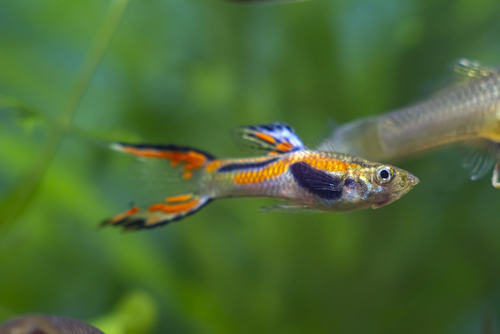
- Scientific Name: Poecilia reticulata
- Adult Size: 1 to 2 inches
- Compatible with: Swordtails, Mollies, Platies
- Care Level: Easy
- Origin: South America
Perhaps the most well-known aquarium fish of them all is the humble Guppy, and they will form a beautiful community with your Harlequin Rasboras. They are adaptable, inexpensive, easy to care for, and make a great beginner species for those who are new to the hobby.
They also have gorgeous tail fins that come in a variety of different patterns and colors, which will really liven up your tank.
Pros:
- Very attractive and easy to care for
Cons:
- Can be vulnerable to fin-nipping tank mates
6. Molly
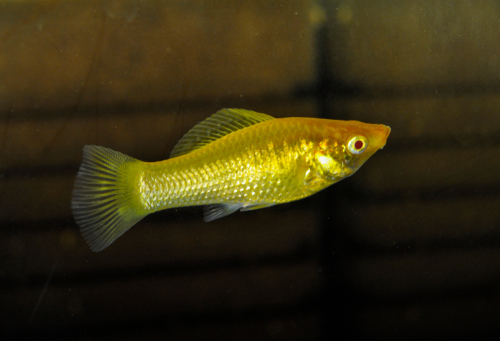
- Scientific Name: Poecilia sphenops
- Adult Size: 3 to 4 inches
- Compatible with: Danios, Cory Catfish, Loaches
- Care Level: Easy
- Origin: Southern US and Central America
A very friendly and varied species, Mollies come in all kinds of colors with all kinds of different patterns and shapes to their tails. They are often given names based on their colorings, such as Dalmation Mollies, Sunset Mollies, or Marble Mollies.
They are rarely hostile and do not harass their tank mates, which makes them a good fit for Harlequin Rasboras.
Pros:
- Peaceful, with a variety of different appearances
Cons:
- Can become stressed in busy tanks
7. Cherry Barb

- Scientific Name: Puntius titteya
- Adult Size: Around 2 inches
- Compatible with: Tetras, Danios, Plecos
- Care Level: Easy
- Origin: Sri Lanka
Many small Barb species can get along well with Harlequin Rasboras, but the Cherry Barb is one of the most compatible and visually appealing. They have a similar temperament to Harlequins and are small in size, so they will not cause each other any stress.
Pros:
- Striking color and small size
Cons:
- Like to move around and are happiest in a 25-gallon tank or larger
8. Neon Tetra
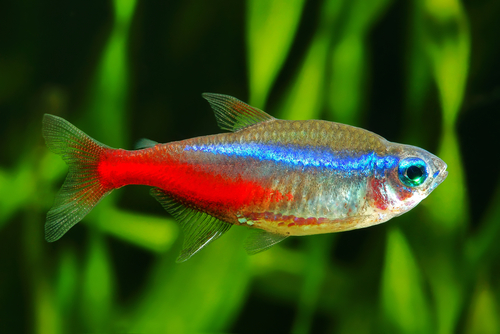
- Scientific Name: Paracheirodon innesi
- Adult Size: Around 1.5 inches
- Compatible with: Hatchetfish, Guppies, Small Rasboras
- Care Level: Easy
- Origin: South America
If you want to add a flash of vibrancy to your tank, Neon Tetras are a great way to go. Like Barbs, there are more than one Tetra species that could happily live alongside Harlequin Rasboras, but Neons are one of the most popular.
They have an incredibly vivid blue and red coloring that really makes them stand out from the crowd, and they are enchanting to watch as a group.
Pros:
- Great for beginners and happy in smaller tanks
Cons:
- Can be vulnerable to larger fish in a community
9. Endler’s Livebearer
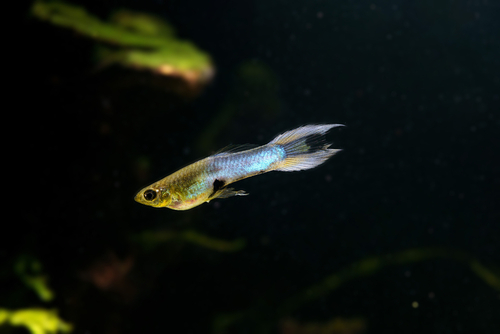
- Scientific Name: Poecilia wingei
- Adult Size: 1 to 1.5 inches
- Compatible with: Small Tetras, Danios, Cory Catfish
- Care Level: Easy
- Origin: Venezuela
These highly entertaining little fish tend to have truly unique patterns on their bodies and a wonderful shape to their tails. They are very active swimmers, but their small size means that they shouldn’t cause your Harlequins any stress.
They can be quite friendly and sociable with other fish, but they are very rarely aggressive.
Pros:
- Beautiful appearance and active behavior
Cons:
- Can be overly inquisitive with other fish
10. Common Hatchetfish

- Scientific Name: Gasteropelecus sternicla
- Adult Size: 1 to 2.5 inches
- Compatible with: Tetras, Cory Catfish, Dwarf Cichlids
- Care Level: Difficult
- Origin: South America
If you’re looking for a schooling fish with a unique appearance, then Hatchetfish could well be the one for you. There are a few different species, but the Common Hatchetfish is the least active, making it the least likely to cause your Harlequins to become anxious.
They are pretty keen predators, though, and they like to jump, which means they can be a little tricky to look after.
Pros:
- Unique shape and interesting behavior
Cons:
- They have more specific care needs than many of the other fish on our list
11. Platy
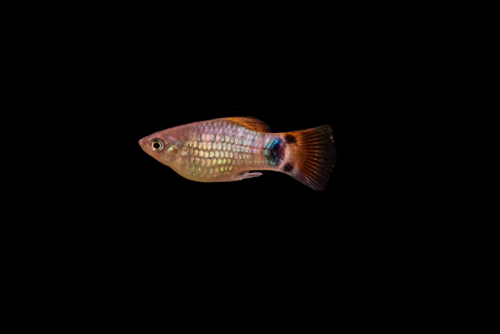
- Scientific Name: Xiphophorus maculatus
- Adult Size: 2 to 3 inches
- Compatible with: Plecos, Small Tetras, Mollies
- Care Level: Easy
- Origin: Central America and Southern Mexico
There are a few species of Platy to choose from, but they are all pretty similar in terms of their personalities and their care needs. They are hardy, peaceful, and have been bred to display some pretty vibrant and distinctive colors.
Among the different varieties, you will find Pintail, Gold Red, Comet, Rainbow, and Tuxedo Platies – to name but a few!
Pros:
- Many varieties to choose from
Cons:
- Tend not to live particularly long
12. Cockatoo Cichlid

- Scientific Name: Apistogramma bitaeniata
- Adult Size: 2 to 3.5 inches
- Compatible with: Kuhli Loaches, Cardinal Tetras, Dwarf Gourami
- Care Level: Medium
- Origin: South America
Any Dwarf Cichlid can be a good fit for your Harlequins, but the Cockatoo Cichlid is definitely one of the most popular. They have a tall dorsal fin and color pattern that is reminiscent of the bird from which they get their name, and they are mostly peaceful and passive.
They can become more aggressive when they are breeding, but they tend to stick around the bottom of the tank and should keep out of the way of your Harlequins.
Pros:
- Attractive fins and coloration
Cons:
- Can be aggressive during breeding time
13. Zebra Danio
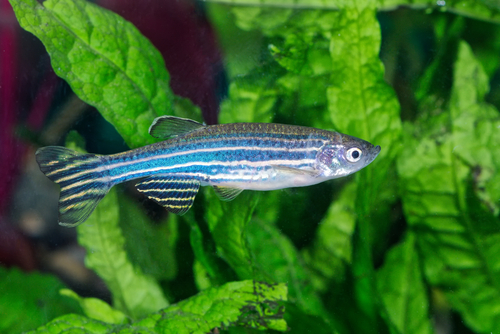
- Scientific Name: Danio rerio
- Adult Size: 1.5 to 2.5 inches
- Compatible with: Dwarf Cichlids, Small Tetras, Swordtails
- Care Level: Easy
- Origin: South Asia
Probably the ultimate Danio species for living alongside Harlequin Rasboras is the Zebra Danio. They come in a variety of colors but are mostly known for the iconic horizontal stripes that mark the sides of their little bodies.
They are both playful and peaceful, which means they are interesting to watch but will rarely cause your Harlequins any kind of trouble
Pros:
- Entertaining and friendly
Cons:
- Can get a little overly playful with their tank mates and will roam into all areas of the tank
Summary
So, which fish are best to keep with Harlequin Rasboras? Generally speaking, you’re looking for tank mates that are non-aggressive and around the same sort of size.
Some of the top choices are other small Rasboras, Cory Catfish, Zebra Loaches, and Dwarf Gourami, but there is actually a wide variety to choose from. Harlequins are pretty easy-going and relatively adaptable, so they get along with a lot more species than some other fish.
Frequently Asked Questions
What are good fish to keep with Rasboras?
Good fish to keep with rasboras of any kind are those that have a similar temperament and are around the same size. Tetras, Loaches, Small Gourami, Barbs, and Mollies are usually good options, as are Cory Catfish.
How many Rasboras should be kept together?
It is best to keep a group of around 10 Rasboras together, although it can vary depending on the specific species.
Can I keep 5 Harlequin Rasboras?
Harlequin Rasboras are usually happier when they are in groups of at least 8, so they might not thrive in a group of only 5.

Ian Sterling, founder of Fishlab.com, began his aquarium journey over 30 years ago, driven by a deep fascination for fish and their diverse personalities. His website, Fishlab.com, is dedicated to making fishkeeping accessible and enjoyable, offering beginner-friendly guidance, expert insights, and a community for aquarists to connect and share experiences.


